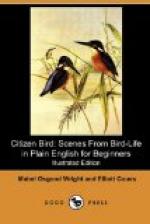“You must always wear your rubber boots when you go to look for the Marsh Wren,” said the Doctor; “and you must be careful where you step, for this Wren knows where to put his nest safely out of the way of both House People and cats. He chooses a bunch of reeds, or a bush that is surrounded either by water or the treacherous green grass of bogs, and there weaves an oblong or globular nest from coarse grass and leaves, with a little hole on one side for a door. This done, he goes to a short distance and appoints himself day watchman to his home. If a footstep touches the grass ever so lightly, he tells his mate of it and they flit off; and if any one thinks that by following the birds they will find the nest, they will be very much disappointed. Mr. and Mrs. Long-bill will lead them a will-o’-the-wisp dance; and when the House People are tired, bewildered, and very wet in the shoes, the clever birds will return home by a secret way, chuckling to themselves. You will know this little bird by his nervous Wren-like ways and jerking tail, even if you are not near enough to see his markings and long curving bill.”
[Illustration: Long-Billed Marsh Wren.]
“But there are no marshy places near the Farm, so I’m afraid we shall never see him, except in the wonder room,” said Nat.
“By and by when we go to the beach, where our river meets the sea, I will show you some nests. I speak of this Marsh Wren now so that you may remember it with the rest of this family of Mockers and Scolders.”
The Long-billed Marsh Wren
Length about five inches.
Upper parts clear brown, with a long light line over the eye, and a patch of black-and-white streaks on the back; light and dark brown bars on tail and wings.
Under parts white, tinged with brown on the sides.
A long slender bill, with more of a curve than a House Wren’s.
Song something like a House Wren’s, but move bubbling and gurgling.
A Citizen of the eastern United States.
A Ground Gleaner.
CHAPTER XII
WOODLAND WARBLERS
“Now you may be introduced to a family of American birds, many of them brightly colored and none of them large, who have no cousins or relations in any other country. You must not expect them to come and peep in the window like the Catbird, or feed on the lawn like the Thrush and Robin; for they are birds of woodland and brushland. Yet the often come for a time in their journeys to gardens and orchards, for they are among the greatest travellers.”
“Why do they travel so much, if they are only American birds?” asked Nat. “I shouldn’t think they would have to go far if they always live in America.”
“America is a very large country, my boy, and you must not forget it includes South as well as North America—the Western Hemisphere of the whole globe. Warblers are insect-eating Citizens and cannot live long on anything else. Now, as many of them nest far North, when the early frosts lock the country they must often make long journeys at short notice, until they find their insect food again.”




